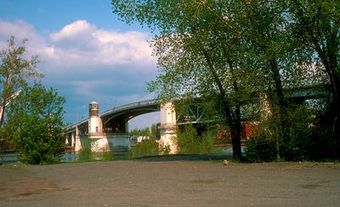Rouyn-Noranda, Qué, City, pop 28 270 (2001c), 30 936 A (1996c), 28 958 (1991c), area 348.07 km2, inc 1986, is the largest centre in the Abitibi-Témiscaming region and its administrative capital.
For many years, Noranda was completely controlled and administered by Noranda Mines, formed in 1922 to exploit one of the richest copper and gold deposits ever found in Canada. The name "Noranda" is a combination of the words "North" and "Canada." Today's vast mining empire, Noranda Inc, grew from the mine which operated 1927-66. The copper smelting plant is one of the largest in Québec and 8 mines are still in operation nearby.
Rouyn is located just south of Noranda on the shore of Lac Osisko. It became a town in 1927 and a city in 1948. Its name honours Jean-Baptiste de Rouyn, a captain in Louis-Joseph de Montcalm's Royal-Rousillon regiment in New France. Rouyn was originally a large mining village inhabited by a mixture of prospectors, miners, adventurers and merchants drawn by the gold rush that erupted in 1922 after discovery of the Noranda mine deposits. Rouyn is still a lively city.

 Share on Facebook
Share on Facebook Share on X
Share on X Share by Email
Share by Email Share on Google Classroom
Share on Google Classroom

